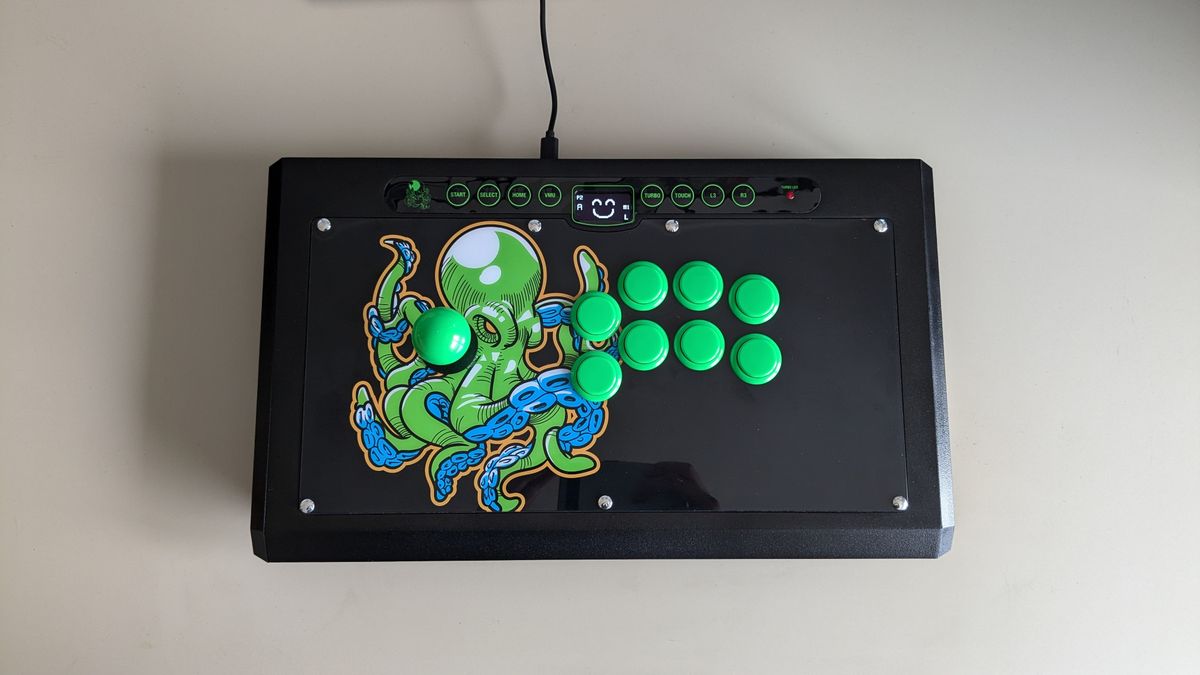Products You May Like
Octopus Arcade Stick: two-minute review
The Octopus Arcade Stick is a versatile fight stick that provides an excellent gaming experience for fighting game fans with exceptional compatibility across a range of platforms. The arcade-grade joystick and buttons from Sanwa benefit from a durable, aerospace-grade aluminum shell.
Indeed, in practice, using it does feel exactly like stepping into the ring on a brawler at your local arcade (minus the beer-soaked cabinets of course). Buttons are responsive and the joystick reliably moves with precision and purpose as you’d expect from a Sanwa stick, always snapping back correctly ready for the next combo, block, or evasion. If Sanwa doesn’t fit your playstyle, then the supplied stick and buttons are easily swapped out for alternatives.
It’s the sheer number of supported consoles and platforms that truly impresses here. Where other contenders for best fight stick can tie players into a single or limited ecosystem, the Octopus Arcade Stick is compatible with over twenty platforms out of the box. Everything from the Mega Drive and SNES, to the entire PlayStation home console family, to PC and even several niche consoles play nicely with TR Fight Stick’s debut behemoth.
Achieving this versatility does require additional cables though, with an array of 2m leads available directly from TR Fight Stick to suit consoles that feature proprietary controller connections that predate the USB standards of today. The included USB-C cable will still provide ample platform coverage across PlayStation 5, PlayStation 4, PlayStation 3, Nintendo Switch, Xbox 360, PlayStation Classic, MegaDrive Mini, NeoGeo Mini, Astro City Mini, MiSTer FPGA, RetroPie, and other Raspberry Pi apps, plus X-Input devices.
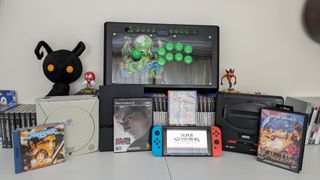
While the Octopus Arcade Stick is happy to throw down on a range of systems, it’s clear that it was designed with Sega’s Dreamcast as its champion. The Octopus’ secret weapon is one strictly for fans of Sega’s final home console, and appears as a built-in virtual VMU (Visual Memory Unit) switcher, with a capacity for ten individual VMUs, providing easy access to more save data slots than even the most prolific Dreamcast player will ever need.
The Octopus Arcade Stick even includes an LCD screen at the top of the unit, allowing you to see at a glance which VMU they’re using and enjoy the little animations, mimicking their appearance on the original Dreamcast VMUs. Soul Calibur fans rejoice as tiny, pixelated Ivy is alive and well.
Serious players also tend to be serious about their fight stick aesthetics, and the Octopus doesn’t disappoint here either with customization options for faceplate designs and layouts, including options to switch from the standard Sega 2P layout to Viewlix, Noir, or HitBox faceplates. Accessing the innards of the Octopus is straightforward, with the rear aluminum plate easily removed by loosening the seven Phillips head screws.
Octopus Arcade Stick: Price and availability
- List price: $399.00 / £297.24 / AU$576.06
- Premium pricing…
- …but early adopters can bag one of the first batch of units for $299
The Octopus Arcade Stick is currently only available from TR Fight Stick’s official store page. The list price of $399.00, roughly £297.24 or AU$576.06 in the UK and Australia respectively, means that the Octopus Arcade Stick comes in as one of the pricier arcade sticks on the market today, costing more than an Xbox Series S or a Nintendo Switch OLED.
While that ticket price may cause some to flinch, remember that the Octopus Arcade Stick’s wide array of compatible consoles and platforms could remove the need for additional peripherals and provide additional value to players wishing to use fight sticks on multiple systems. Even those looking for a fight stick for a single platform should feel confident in their purchase as the quality on display in the Octopus is stellar.
Mercifully, those aforementioned additional cables carry a reasonable $14.99 price tag so won’t break the bank for players looking to wield the Octopus on older systems.
The Octopus Arcade Stick is scheduled to launch sometime in October, and early adopters can snap up a unit in either black or white for $299 while TR Fight Stick’s initial stocks last.
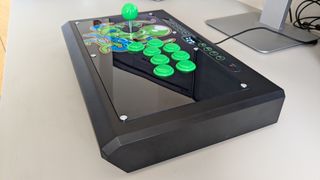
Octopus Arcade Stick: Specs
| Price | $399.00 (about £297.24 / AU$576.06) |
| Connectivity | Wired |
| Cable length | 6.5 ft / 2m |
| Weight | 7.7 lbs / 3.5kg |
| Dimensions | 17.5in x 10.2in x 2.3in / 44.5cm x 26cm x 6cm |
| Joystick | Sanwa |
| Buttons | Sanwa |
| Profile support | No |
| Customization | Sticks, buttons, faceplates |
| Compatibility | PS1, PS2, PS3, PS4, PS5 (fighting games only), NES, SNES, N64, GameCube, Switch, PC, Steam Deck, Mister FPGA, Xbox 360, Sega Mega Drive, Sega Saturn, Sega Dreamcast, Neo Geo AES, SuperGun, PS Classic, Mega Drive Mini, NeoGeo Mini, Astro City Mini, RetroPie and other Raspberry Pi apps, X-Input devices |
| Software | Frimware updates only via PC |
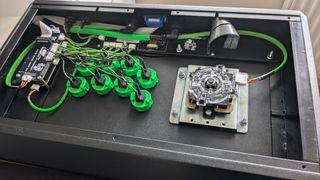
Octopus Arcade Stick: Design and features
- Striking visuals with a range of changeable faceplates
- Fantastic build quality with high-end materials
- Bulky and heavy
Probably the first thing that’ll catch your eye on the Octopus Fight Stick is the artwork. TR Fight Stick has produced a series of faceplates, dubbed ‘OctoPlates’, allowing users to change the appearance of their arcade sticks. The majority of the OctoPlates include artwork featuring the titular cephalopod in a number of graphic styles, with designs inspired by everything from street graffiti to Grecian mosaics. If tentacles aren’t your thing, however, there is also a transparent OctoPlate which shows off the units’ inner workings, and even a limited edition plate featuring Ryo Hazuki from Dreamcast classic Shenmue.
There’s no avoiding the octopus in the room though, no matter how it’s dressed, the Octopus Fight Stick is a hefty unit. The chassis size is a significant increase over the prototype I tested back at the start of the year, measuring almost 17.7in / 45cm across its width and 10.2 / 26cm deep. After opening the back of the unit to inspect modification options, I gleamed that there exists plenty of free space internally, meaning that TR Fight Stick could potentially slim this design down without greatly impacting its overall visage.
It’s not just the size of the Octopus either, but the weight, that may dissuade some would-be buyers. Tipping the scales at around 7.7lbs / 3.5kg, the Octopus Arcade Stick definitely falls into the heavyweight category alongside other sticks such as the Nacon Daija and the Victrix Pro FS. Personally, I don’t mind the weight resting on my lap during a gaming session, as it feels secure and unlikely to move around during play, however, its weight may be off-putting to some.
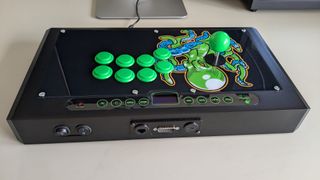
Octopus Arcade Stick: Performance
- Exceptionally responsive buttons and stick
- Switching between platforms is a little fiddly yet forgivable
- Fantastic for arcade games and retro titles as well including a well-implemented turbo function
When you’re in the heat of battle the last thing you want to worry about is an unresponsive controller, and the Octopus Arcade Stick uppercuts those concerns into oblivion. The sturdy metal case eliminates any flex you might experience with a plastic shell, with the buttons and stick feeling purposeful and reliable during heated online exchanges.
A far cry from ‘the claw’ I often use when playing the best fighting games with something like one of the best PC controllers, the Octopus’ size affords a comfortable space for players to rest their wrists during gameplay, with the ergonomic layout putting every button at my fingertips, ready to engage at a moment’s notice. I found using the Octopus left me feeling less fatigued following a long play session, no doubt thanks to not needing to unnaturally wrap my digits around a pad.
The joystick offers similarly high levels of responsiveness, with dashes, blocks, and circle movements all feeling immediate while delivering that satisfying clicky feedback one only gets with an arcade stick. Special moves quickly become second nature and the experience of inputting button and directional sequences truly captures that arcade machine feeling.
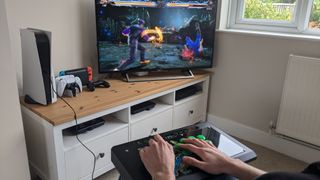
The majority of my review time was spent online in Tekken 8 on PS5, however, I was pleasantly surprised to see how easy it was to move between the various platforms the Octopus Arcade Stick supports.
TR Fight Stick provided me with a range of cables, allowing me to connect to all manner of systems. Plugging the fight stick into each one for the first time does require a bit of dexterity though. The first step is to connect the cable to the console or PC, before holding either a single-button or a two-button combo while inserting the other end of the cable into the Octopus Arcade Stick. It’s not the most elegant of methods for connecting, but with so many platforms supported it feels like TR Fight Stick has achieved a relatively painless process.
Similarly, the VMU switching on Dreamcast is vastly improved from the prototype model I’ve tested previously. Flicking between memory cards on Dreamcast now requires you to hold a single, dedicated button labeled ‘VMU’ before flicking the joystick left or right, whereas the prototype required me to contort my fingers unnaturally and enter a sequence of prompts to achieve the same thing.
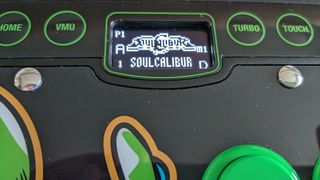
All initialization fumbling is quickly forgotten however once you’ve booted up your game of choice. A handy rocker switch on the unit’s far side allows you to quickly toggle the joystick function between left and right analog sticks or a d-pad input, making navigating menus a breeze. Whether playing on PlayStation, PC, Mega Drive, Dreamcast, or Switch, the button and stick inputs remained sharp and responsive, with no noticeable lag present at all.
As a big retro-head, I was keen to take the Octopus Arcade Stick out of its natural brawler habitat and throw some stone-cold classics its way. Far from a one-genre master, the Octopus delivered a fantastic gaming experience across puzzle games like Dr. Robotnik’s Mean Bean Machine on the Mega Drive and even excelled on the challenging platforming of Disney’s Aladdin. The Octopus’ performance in the latter even led to me reaching the penultimate level of the game in a single life, something I’ve never achieved on a control pad.
Should you buy the Octopus Arcade Stick?
Buy it if…
Don’t buy it if…
Also consider…
If you’re in the market for a premium fight stick but not completely sold on the Octopus then here are two other similar arcade sticks for your consideration. It’s worth highlighting however the list of compatible platforms on these alternatives is much smaller than the Octopus Arcade Stick, however, that may not be an issue if you’re only looking to play on modern PlayStation or PC hardware.
| Row 0 – Cell 0 | Octopus Fight Stick | Victrix Pro FS | Nacon Daija |
| Price | $399.00 (about £297.24 / AU$576.06) | $399.99 / £335.99 / AU$699 | $292 / £240 / AU$462 |
| Connectivity | Wired | Wired | Wired |
| Cable length | 6.5ft / 2m | 10ft / 3m | 10ft / 3m |
| Weight | 7.7lbs / 3.5kg | 7.6lbs / 3.4kg | 10.2lbs / 4.64kg |
| Dimensions | 17.5in x 10.2in x 2.3in / 44.5cm x 26cm x 6cm | 16.25in x 11in x 2.25in / 41.2cm x 27.9cm x 5.7cm | 17.1in x 11.6in x 6.2in / 43.5cm x 29.5cm x 15.9cm |
| Joystick | Sanwa | Link 2 | Sanwa |
| Buttons | Sanwa | Sanwa | Sanwa |
| Profile support | No | No | Yes |
| Customization | Sticks, buttons, faceplates | Sticks, buttons | Sticks, buttons, faceplates |
| Compatibility | PS1, PS2, PS3, PS4, PS5 (fighting games only), NES, SNES, N64, GameCube, Switch, PC, Steam Deck, Mister FPGA, Xbox 360, Sega Mega Drive, Sega Saturn, Sega Dreamcast, Neo Geo AES, SuperGun, PS Classic, Mega Drive Mini, NeoGeo Mini, Astro City Mini, RetroPie and other Raspberry Pi apps, X-Input devices | PS5, PS5, PC | PS5, PS4, PC, Xbox Series X|S, Xbox One (separate variants) |
| Software | Firmware updates only via PC | Firmware updates only via PC | Configurable via software |
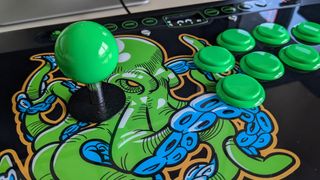
How I tested the Octopus Arcade Stick
- Tested for a week on PS1, PS2, PS3, PS4, PS5, PC, Mega Drive, Dreamcast, and Nintendo Switch
- Tested with multiple beat ‘em ups, arcade and retro titles
- Competed in online tournaments
As somebody who indulges in online battles of Tekken 8 daily, I replaced my PS5 DualSense Wireless Controller with the Octopus Arcade Stick for the duration of my week-long review period, clocking in roughly ten hours of ranked, online gameplay in Namco Bandai’s seminal beat ‘em up. I’ve also become accustomed to entering PS5 tournaments in Tekken 8 so again used the Octopus Fight Stick for my daily humbling with some of the best players on the platform.
I also explored Tekken’s history on PlayStation using the Octopus, connecting the unit to my PS1, PS2, PS3, and PS4. I also took this opportunity to play an hour or so of the wonderful Street Fighter 30th Anniversary Collection, fighting through various arcade modes and in the online lobbies.
Moving away from PlayStation, I took several of my favorite Mega Drive classics for a spin during my regular retro game day. In addition to the aforementioned Mean Bean Machine and Aladdin, I used the Octopus Arcade Stick to play through the first half of Sonic 2 and hopped my way through to Pizza Planet in Toy Story.
I tested Nintendo’s platforming pedigree next, firing up several classic titles from the Mario series on Switch before diving headlong into Super Smash Bros. Ultimate for some competitive local multiplayer with my partner and friends.
Those same friends kindly provided me with a Dreamcast and some games, including a copy of Soul Calibur, so I could put the Octopus’ VMU features through its paces.
Lastly, on the PC side of things, I enjoyed bouts of Killer Instinct and Multiversus, before throwing myself back into Cuphead and making generous use of the Octopus’ turbo functions.
First reviewed October 2024
